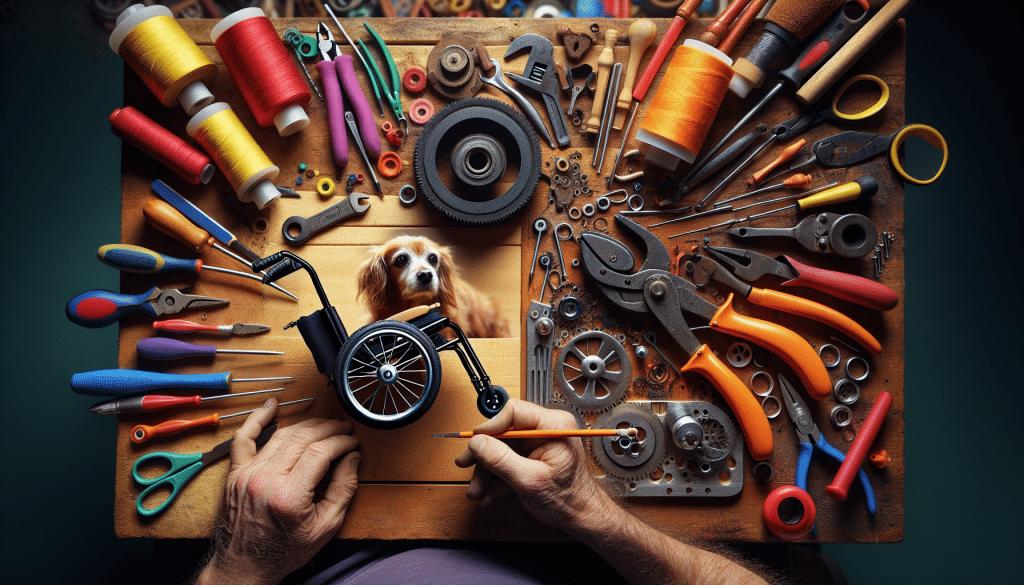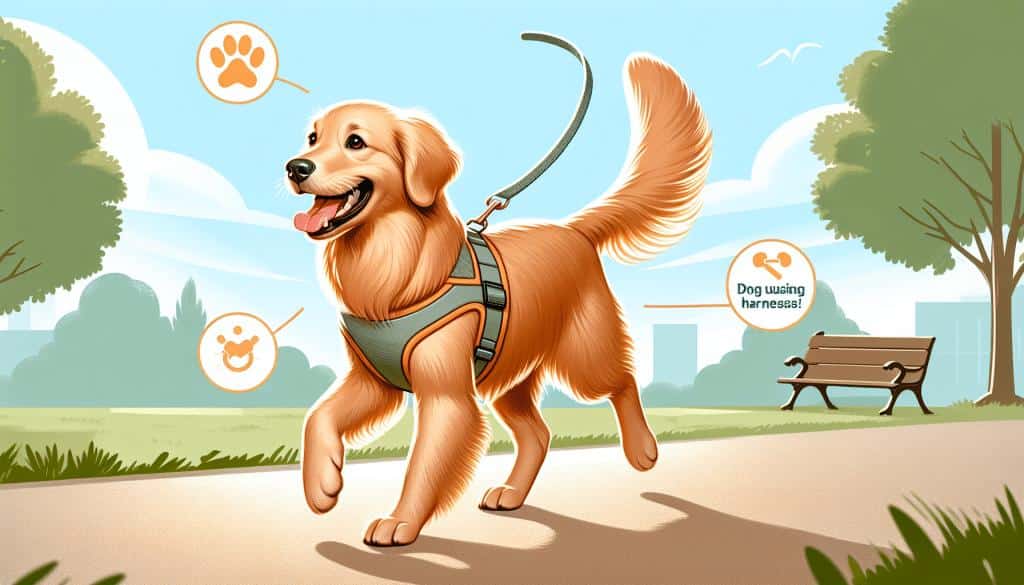So you’ve found yourself in a situation where your beloved furry friend is in need of a wheelchair to regain their mobility. Don’t fret, because we’ve got you covered with a step-by-step guide on how to build a dog wheelchair. Whether your dog has suffered from an injury or is dealing with mobility issues, this guide will provide you with all the necessary information and instructions to create a customized and functional wheelchair for your pet. Get ready to embark on a rewarding and hands-on project that will not only help your dog, but also strengthen the bond between the two of you.
Understanding the Need for a Dog Wheelchair

Recognizing mobility issues in your dog
If you have noticed that your dog is struggling with mobility and is having difficulty walking or standing, it’s important to recognize these signs as potential mobility issues. Some common signs include limping, dragging their hind legs, or overall weakness. It’s important to pay attention to any changes in your dog’s mobility and consult with a veterinarian to determine the cause and potential solutions.
Consulting with a veterinarian
When you notice mobility issues in your dog, it’s crucial to consult with a veterinarian. They will be able to diagnose the underlying cause of the mobility issues and recommend appropriate treatment options. The veterinarian might suggest a dog wheelchair to improve your dog’s mobility and overall quality of life. They will be able to guide you through the process of measuring, building, and fitting a dog wheelchair specifically tailored to your dog’s needs.
Considering the benefits of a dog wheelchair
A dog wheelchair can provide numerous benefits to your furry friend. Firstly, it helps your dog regain and maintain their mobility, allowing them to move freely and independently. This can greatly improve their quality of life and overall happiness. Additionally, a dog wheelchair can help strengthen their muscles and prevent further complications caused by limited mobility. It also allows your dog to continue participating in activities they enjoy, such as walks or playing fetch. Overall, a dog wheelchair can significantly improve your dog’s overall well-being and ensure they lead a fulfilling life.
Overview of Dog Wheelchair Design
Typical design elements of a dog wheelchair
Dog wheelchairs generally consist of a frame, wheels, and a harness. The frame is designed to support the dog’s body and provide stability, while the wheels allow for easier movement and mobility. The harness helps secure your dog in the wheelchair and ensures a comfortable fit. Understanding these design elements is essential when building a dog wheelchair.
Understanding the structure and functionality
The structure of a dog wheelchair is typically made of lightweight and sturdy materials such as aluminum or stainless steel. This ensures durability and ease of movement for your dog. The frame should be adjustable to accommodate your dog’s measurements and requirements. The wheels should be of appropriate size and material to provide smooth movement and support on various terrains.
Different types of dog wheelchairs
Dog wheelchairs come in different types, depending on the specific needs of your dog. Rear wheelchairs are designed for dogs with hind leg mobility issues, while front wheelchairs are suitable for dogs with forelimb issues. Full support wheelchairs are ideal for dogs with limited mobility in both the front and hind legs. It’s important to determine which type of wheelchair is best suited for your dog’s specific needs before proceeding with the building process.
Measuring Your Dog Correctly
Taking measurements of height, length, width
Accurate measurements are crucial when building a dog wheelchair. To measure your dog’s height, measure from the ground to the top of their back. For length, measure from the base of their neck to the base of their tail. Width can be measured by placing a measuring tape around the widest part of their body, usually behind the front legs. Make sure to write down these measurements accurately to ensure a proper fit for the wheelchair.
Importance of precise measurements
Precise measurements are essential to ensure the comfort and effectiveness of the dog wheelchair. An ill-fitting wheelchair can cause discomfort and hinder your dog’s mobility even further. By taking accurate measurements, you can be confident that the wheelchair will properly support your dog’s body and provide the necessary stability.

How to ensure comfortable fitting
To ensure a comfortable fitting, it’s important to consider your dog’s specific needs and measurements. A comfortable fitting wheelchair should allow your dog to move freely without any restrictions or discomfort. The harness should be adjustable and snug but not too tight. Remember to periodically check the fit and make necessary modifications as your dog grows or their mobility changes.
Choosing the Right Materials
Discussion of suitable materials
When selecting materials for your dog wheelchair, it’s important to consider their durability, weight, and comfort. Aluminum and stainless steel are commonly used for the frame due to their lightweight yet sturdy nature. The harness should be made of soft, breathable materials to prevent chafing or irritation. It’s crucial to choose materials that are strong enough to support your dog’s weight yet gentle on their skin.
Benefits of lightweight and robust materials
Using lightweight materials ensures that the wheelchair is easy for your dog to maneuver while also minimizing any additional strain on their body. Robust materials provide the necessary support and stability required for your dog’s mobility. It’s important to strike a balance between durability and weight to create a wheelchair that is both functional and comfortable for your furry friend.
Care and maintenance of materials
Regular care and maintenance of the materials used in the dog wheelchair are necessary to ensure their longevity. Clean the frame and wheels regularly to prevent the buildup of dirt and debris. Check the harness for any signs of wear and tear and replace it if necessary. By taking proper care of the materials, you can extend the lifespan of the wheelchair and ensure your dog’s continued comfort and safety.
Assembling the Frame
Creating the main structure
Assembling the frame of the dog wheelchair requires careful attention to detail. Follow the instructions provided by the wheelchair manufacturer or consult with a veterinarian for guidance. Start by attaching the main support beams to create the frame’s structure. Ensure that all connections are secure and stable, as this will be the foundation of the wheelchair.
Attaching components properly
Once the main structure is in place, it’s time to attach the various components of the wheelchair. This includes adding brackets for the wheels, adjusting bars for height and length, and connecting the harness system. Each component should be securely attached according to the manufacturer’s instructions, ensuring proper alignment and functionality.
Ensuring stability and balance
Before finalizing the assembly, it’s crucial to ensure that the wheelchair is stable and balanced. Test the wheelchair on a flat surface and observe how it supports your dog’s weight. If there are any signs of instability or imbalance, make the necessary adjustments to ensure your dog’s safety and comfort. The wheelchair should provide enough stability to allow your dog to move freely without tipping over.
Adding the Wheels
Selection of appropriate wheels
Choosing the right wheels for your dog’s wheelchair is essential for their mobility. Consider the size, material, and tread of the wheels. Larger wheels are suitable for outdoor use and rough terrains, while smaller wheels are ideal for indoor use or smooth surfaces. Select wheels that offer good traction and stability, allowing your dog to move comfortably and without slipping.

Securing wheels to the frame
Attach the wheels securely to the frame of the wheelchair, ensuring that they are aligned and properly fastened. Check that the wheels can rotate freely without any obstruction. Test the wheelchair on different surfaces to ensure smooth movement and stability. Making sure the wheels are properly secured will prevent any accidents or discomfort for your dog during use.
Effective mobility with the wheels
With the wheels attached, your dog’s mobility will improve significantly. The wheels allow your dog to move with ease, whether indoors or outdoors. Ensure that the wheels are functioning properly and the wheelchair rolls smoothly. Regularly check the wheels for any signs of wear and tear and replace them if necessary. With the right wheels, your dog will be able to enjoy improved mobility and independence.
Creating a Comfortable Harness
Designing a harness that fits well
The harness is a crucial component of the dog wheelchair, as it ensures that your dog remains secure and comfortable while using it. Design a harness that fits well and provides support to the body without restricting movement. Consider utilizing soft materials that won’t chafe or irritate your dog’s skin. Ensure that the harness is adjustable and enables a proper fit for your dog’s specific measurements.
Choosing materials for comfort
When choosing materials for the harness, prioritize your dog’s comfort. Look for soft, breathable materials that won’t cause any friction or discomfort. Avoid materials that are too rough or rigid, as they can cause irritation or restrict your dog’s movement. Carefully selecting the materials will ensure that your dog can wear the harness for extended periods without any discomfort.
Securing the harness to the frame
Once the harness is designed and properly adjusted, secure it to the frame of the wheelchair. Check that the harness is securely fastened and properly aligned to provide maximum support to your dog’s body. Regularly inspect the harness for any signs of wear and tear and make any necessary adjustments or replacements. A well-fitted and secure harness is crucial for your dog’s safety and comfort while using the wheelchair.
Adjusting for Proper Fit
Fine-tuning the frame and harness
After the wheelchair is assembled and the harness is attached, it’s essential to fine-tune the fit for your dog’s comfort and mobility. Make any necessary adjustments to the frame, harness, or other components to ensure a perfect fit. Pay attention to your dog’s movements and any signs of discomfort or restriction. Regularly check and modify the wheelchair as your dog grows or their mobility changes over time.
Checking for any discomfort or pain
Once your dog is in the wheelchair, monitor them closely for any signs of discomfort or pain. Observe their movements and behavior to ensure that the wheelchair is not causing any pressure points or unnecessary strain on their body. Make any necessary modifications to alleviate any discomfort or pain, such as adjusting the harness or adding additional padding to sensitive areas.
Making necessary modifications
As your dog’s needs change or their mobility improves, it may be necessary to make modifications to the wheelchair. This could include adjusting the height or length of the frame, replacing worn-out parts, or upgrading certain components. Regularly assess your dog’s needs and consult with a veterinarian to determine if any modifications are necessary to ensure your dog’s continued comfort and mobility.
Introducing Your Dog to the Wheelchair
Guidelines for the first interaction
Introducing your dog to the wheelchair requires patience and positive reinforcement. Start by allowing your dog to explore and sniff the wheelchair in a calm environment. Gradually introduce them to wearing the harness and sitting in the wheelchair. Reward your dog with treats and praise to create positive associations. Take your time and progress at your dog’s pace, allowing them to adjust and become comfortable with the wheelchair.
Training your dog to move with the wheelchair
Once your dog is familiar with the wheelchair, begin training them to move while wearing it. Start in a controlled environment and encourage your dog to take a few steps while supporting their rear or front legs as needed. Reward your dog for any effort and progress they make. Gradually increase the distance and duration of their walks as they gain confidence and strength. Consistency and positive reinforcement are key during the training process.
Monitoring your dog’s reaction
Throughout the training process, closely monitor your dog’s reaction and behavior. If you notice signs of distress or discomfort, temporarily reduce the duration or intensity of their wheelchair usage. Pay attention to any changes in your dog’s mobility or overall well-being and consult with a veterinarian if necessary. Your dog’s safety and comfort should always be the top priority when using a wheelchair.
Maintaining and Improving the Wheelchair
Routine checks and maintenance
Regularly inspect the wheelchair for any signs of wear and tear. Check the frame, wheels, and harness for any loose screws, broken parts, or frayed materials. Clean the wheelchair regularly to remove any dirt or debris that may affect its functionality. By conducting routine checks and maintenance, you can ensure that the wheelchair remains in good condition and provides optimal support and comfort for your dog.
Spotting and fixing issues
During routine maintenance, be vigilant in spotting any issues or concerns with the wheelchair. If you notice any loose or broken parts, address them immediately. Replace any worn-out or damaged components to maintain the wheelchair’s integrity and prevent any further damage or discomfort to your dog. Regularly inspecting and fixing issues ensures that the wheelchair remains safe and functional for your furry friend.
Upgrading or modifying the wheelchair over time
As your dog’s mobility improves or their needs change, you may consider upgrading or modifying the wheelchair. This could involve replacing certain components to accommodate your dog’s growth or purchasing additional accessories to enhance their comfort. Consult with a veterinarian or wheelchair manufacturer for guidance on potential upgrades or modifications. Regularly evaluating and improving the wheelchair will help ensure that it continues to meet your dog’s mobility needs effectively.
Building a dog wheelchair is a step-by-step process that requires careful consideration of your dog’s individual needs and measurements. By understanding the need for a dog wheelchair, properly measuring your dog, choosing the right materials, assembling the frame, adding the wheels, creating a comfortable harness, adjusting for proper fit, introducing your dog to the wheelchair, and maintaining and improving the wheelchair, you can provide your beloved furry friend with the mobility and independence they deserve. Remember to always consult with a veterinarian for guidance and support throughout the process. With your love and dedication, your dog will be able to enjoy an improved quality of life and continue to be an active and joyful companion.



